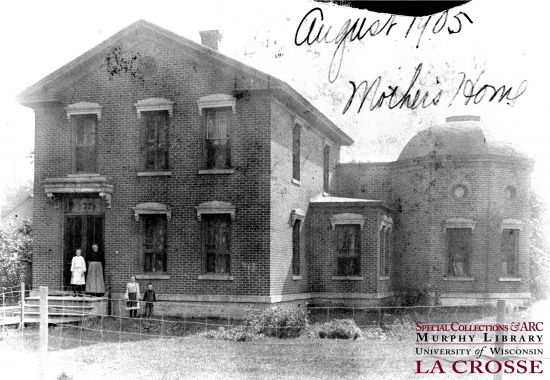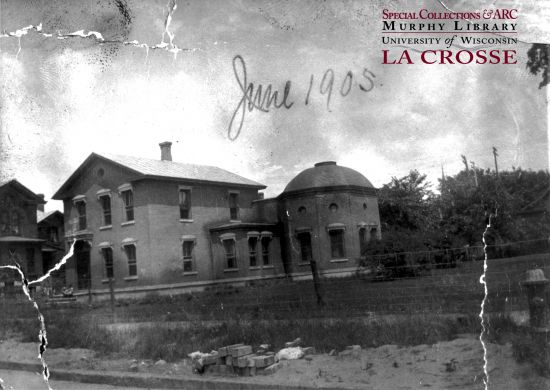
The Octagonal Mystery
(written by Dr. Les Crocker, retired art history professor and architectural historian)
It was not a good day. Late-November sleet bounced off the windows of the Special Collections in Murphy Library and rain-braided streams ran down the glass. It was getting to that point in the afternoon when everyone is drowsy and thinking about going home. I had looked at hundreds of photos in the last three hours and I was drooping. My search was for old houses – not old like your grandmother, but really old, like 1850s old.
I had looked at photos for all the named streets and was working on the numbered streets. I opened the box for South Fourth Street and pulled out a large envelope. Three photos slid out. I saw a two-story house three bays wide with Italianate details and an attached section that was octagonal in shape.

A slow day searching through photographs yielded a mystery to be solved when I happened upon these pictures of a house with what looks like a domed octagonal structure attached to it. (Photos provided courtesy of UW-La Crosse Murphy Library Special Collections.)

“AN OCTAGONAL BUILDING!”
I was no longer drowsy.
The photos showed a rectangular, brick house, approximately 18 feet wide and 32 feet long, two stories high, three bays wide, with an entrance at the left bay. It was a simple house with Italianate style details. There was a heavy stone hood over the entrance and smaller, but matching, window heads. There was a one-story extension or bay window on the side near the rear of the house, one bay deep and two bays long. The peculiar portion of the house seemed to be an octagonal building about 20 feet in diameter, linked to the house and the bay with a brick wall. There is a low saucer dome on the octagon with a low curb around it. I was reminded of the Pantheon in Rome with its saucer dome and oculus, an opening in the center for light.
I had never seen or heard of a domed octagonal building in La Crosse. In fact, other than a handful of very old buildings in Italy, I had never seen an octagonal domed building at all. Certainly there was the octagon fad in mid-19th century housing, but they were a larger scale and even the best of them never had a dome. Towers were popular in the middle decades of the 19th century, but this was not a tower.
What was it? Who built it? Why was it built? When was it built? I showed a copy of the photos to everyone I knew who might help. I got a variety of suggestions as to its function – silo, astronomical observatory, private chapel, art gallery, recital hall for music or singing – but there was no evidence to support any of them.
The stone foundation of the house, the bay and the octagon seemed to be the same material and at the same height. Likewise, a stone belt course above the foundation was continuous and seemed all of a similar material. There was a window in each of the two visible sides of the octagon and two windows in the side farthest from the house. The windows were at the same level as the ground-floor windows of the house and seemed to have the same thick window heads. Curtains were visible in one of the photos, suggesting that the windows were functional. Above the windows in the octagon were small circular openings that appeared to be decorative.
All of which says the parts were either built at the same time or veneered with brick and stone details at the same time. Frame houses in La Crosse were often given brick veneers to improve their appearance and make them more fireproof.
Written on one of the photos is “721 S. Fourth, Fourth & Ferry, c.1905 John Dressen home.” That address gave me a lead I could use to trace this peculiar building.
The 1905 La Crosse city directory lists Mary Dresen, widow of John Dresen, at 721 S. Fourth, and a William Dresen at the same address. So the date and location on the photograph and the city directory are consistent.
Checking earlier directories showed that in 1890 the house belonged to John Levy; so John Dresen lived in the house at 721 S. Fourth St. a brief time and probably wasn’t connected to construction of the mysterious octagon. I knew John Levy was an early settler and important to La Crosse history. Now this house and octagon mystery became even more important. Why did one of the leading merchants of La Crosse have a domed octagon attached to his house?
Using the Sanborn fire insurance map of La Crosse from 1891, the first such atlas that recorded that area of the city, I found a simple ground plan of the house which showed that what seemed an octagon in the photographs was an irregular room that was connected to the kitchen.

A layout of the Levy house at 721 4th St. S. is seen on the 1891 Sanborn fire insurance map.
According to C.W. Butterfield’s 1881 History of La Crosse County, Levy’s house was built in 1854 by early resident Albert La Due. Levy purchased the house sometime before 1857, as he is listed as the owner when the first property tax was recorded for the city. Property tax records can be helpful in dating a building or parts of a building, since new construction or remodeling results in higher property taxes.
In 1869 Levy enlarged and remodeled his house. The original house was a one- or two-room building, perhaps with a loft or half-story above. The old house may have been incorporated into the new structure, probably as the kitchen.
A newspaper article from the June 11, 1869, La Crosse Daily Democrat indicated that W.H.J. Nichols was the architect of Levy’s house. The newspaper editor ranked it among the best houses in the city.
The newspaper list of new buildings in La Crosse seen in the Dec 11, 1869, La Crosse Leader gave more information: J.M. Levy built a conservatory at a value of $1,500. Levy owned two lots, and taxes in 1869 for the lot where the octagonal building was located went up while the value of the house lot stayed the same. This clearly showed the location and date of the mysterious octagon. The octagon conservatory was a greenhouse built in 1869.
 This advertisement from the 1868 La Crosse city directory clearly shows that people were growing indoor flowers. Conservatories may have been more common than we had thought. Bay windows were also a favorite spot for flowers, so even modest houses could have some greenery during the winter.
This advertisement from the 1868 La Crosse city directory clearly shows that people were growing indoor flowers. Conservatories may have been more common than we had thought. Bay windows were also a favorite spot for flowers, so even modest houses could have some greenery during the winter.
Though it appeared much later, a brief article in the Dec. 28, 1941, “Curbstone Pickups” column of the La Crosse Tribune gave the conclusive information. Mrs. Jean Farnam, the daughter of Robert Calvert, remembered the Levy house very well. Her father and Levy were both interested in horticulture. She recalled the area around the Levy house filled with fruit trees and flowers. The La Crosse area was a new environment that required new varieties of plants to be developed for this particular climate and soil. John Salzer’s seed company is the best known of these local efforts, but there were many amateur horticulturists who contributed to the list of plants hardy enough to survive the La Crosse winters.
Mrs. Farnam recalled a night when she was very young but was taken to the Levys’ for a special event. John Levy’s night-blooming cereus cactus had a blossom that was ready to open and friends came to see the once-a-year event. Fredericka Augusta Levy served cookies.
In 1886 the front addition, the bay and the conservatory were veneered with brick and stone trim, giving us the house that is shown in the photographs that started this search.

The 1891 Sanborn map shows Levy’s house at 721 S. 4th St., seen on the right in this image. Notice to the left that 325 Ferry St. has a peculiarly shaped addition on the rear. Its longest wall also faced east. I don’t know the construction date of the building at 325 Ferry St. It is in the 1885 city directory, but not 1884, so it may have been built in 1884. Carl Ulrich, teacher of German, and Miss Lena Moser, teacher of German, lived there in 1885. Perhaps the Levys weren’t the only ones with a conservatory.
William Nichols designed the remodeling and enlarging of the Levys’ house at the time of the “octagon.” Nichols also designed the commercial buildings that Levy owned at Front and Pearl streets. It was a small community and they knew each other. Fredericka Levy was a significant figure in her own right and must be included in the equation. Fredericka and John wanted some place to grow plants or perhaps kitchen herbs. Nichols, perhaps thinking of the octagon houses in West Salem that he would have seen when working on several houses in that community, came up with a design that was distinctive and functional.
The conservatory is gone by the time of the 1910 revisions on the 1906 Sanborn map, and the house is listed as “Flats” so it had been subdivided after Levy’s death. When the house was finally razed about 1985, no one remembered that it had been the home of one of the most interesting couples ever to live in the city. It was just another old house – the old house of a university-educated, European Jew who was a trail maker, fur trader, storekeeper, a tough fighter, mayor, alderman, caring father and grandfather, horticulturist, steamboat owner and friend of all.
The question I really would like to answer – but can’t – is why this odd building was never mentioned in the last century and a half. It was an uncommon building created by three uncommon people.

